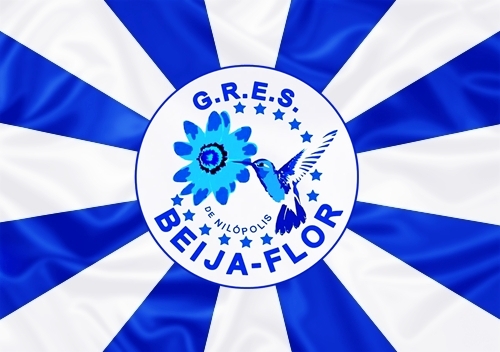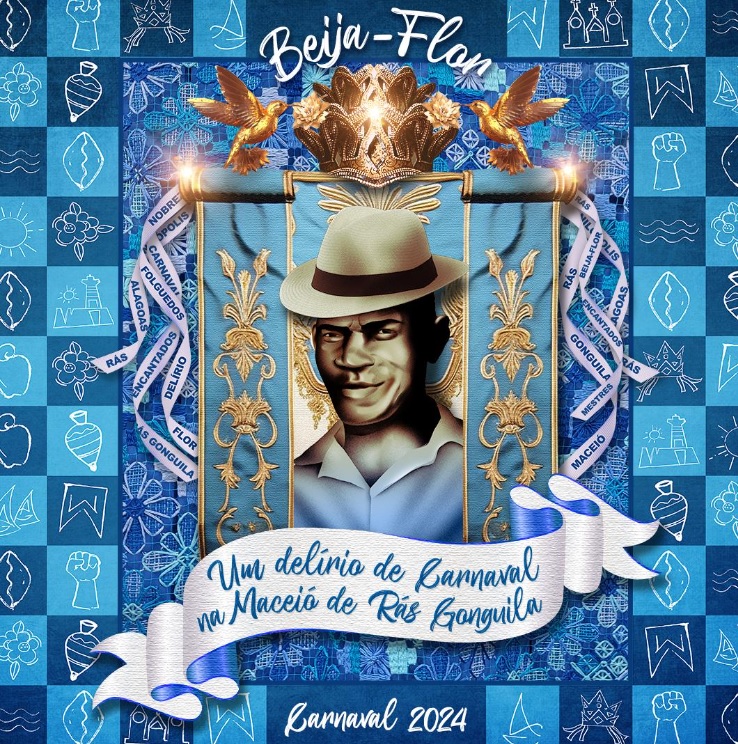- Your cart is empty
- Continue Shopping
Hummingbird




/i.s3.glbimg.com/v1/AUTH_59edd422c0c84a879bd37670ae4f538a/internal_photos/bs/2023/B/u/03fbAoR6WgzjAjJ3PHdQ/dsc-6941.jpg)

Technical Sheet 2024
- Plot: “A Carnival frenzy in Maceió by Rás Gonguila”
- Carnival artists: João Vitor Araújo
- President: Almir Reis
- Vice-President: Biel Maciel
- Honorary President: Anízio Abraão David
- Carnival Director: Dudu Azevedo
- General Directors of Harmony: Simone Santana and Válber Frutuoso
- Interpreter: Little Black Hummingbird
- Drum Masters: Rodney and Plínio
- Drum Queen: Lorena Raissa
- Master of Ceremonies and Flag Bearer: Claudinho and Selminha Sorriso
- Commission of Front: Jorge Teixeira and Saulo Finelon
“A Carnival frenzy in Maceió
of Ras Gonguila”

GRES Hummingbird | Carnival 2024
Synopsis – SUMMARY
Who will be Benedito?
A boy named Benedito, surnamed dos Santos, was born in Maceió in 1905. He was born on a street that no longer exists, in a part of the city that smells of magic and sea air, between the churches of Nossa Senhora do Rosário dos Pretos and São Benedito. Little is known about his father and mother. Their names and memories have turned to ashes. The only thing we know for sure about them is that they suffered the horror of slavery in their souls. Freed and illiterate, they earned their living selling fruit on the streets of the old city or cleaning the mansions of the sugar barons.
In the boy's ear, they whispered enchanting stories of ancestors who were kings and queens in an African country, distant Ethiopia, and who paraded their royalty up there in the heights of Serra da Barriga. The tradition that crossed generations took Benedito back to the time of Palmares, the largest of the quilombos, whose noble blood still runs through the veins of Alagoas. A time of pain and struggle, but also of resistance and celebration, when Benedito heard from his parents: “My son, a party day was a day to rest our weapons.”
Lower your shield, quilombola warrior. Put your arrow to rest, brave caeté-wassu. Today we will dance with the spirits of our ancestors in caboclo shamanism, beliefs of popular Catholicism and rituals of Mother Africa! It is the day to make our songs and drums resonate for eternity! Thus, under the protection of fig trees and juremas, those who resisted the lash and did not bend their knees gave rise to a people who play without losing faith in their roots.
He's the one in charge of the Maceió festivities
Even before Benedito was born, Abyssinia – the old name for Ethiopia – was already inspiring parties and processions in the center of Maceió, a region that the newspapers of the time called Maceyobissinia. It was a piece of Africa in the capital of Alagoas, where kids would spend their time on the sunny streets. When they didn't spin the top properly and it fell to the ground, they would say it was a 'gong'. Benedito's lack of skill with the wooden toy and cotton string earned him the nickname Gonguila.
He learned to be a shoe shiner and worked as a shoe polisher. He chatted on the sidewalks, shining the shoes of politicians, artists and intellectuals at the doors of cafes and tobacconists. But it was among drunks, prostitutes and the unemployed that he liked to be the most, drinking and smoking, playing cards and playing pool. It was in the bohemian world and at the crossroads that Gonguila honed his greatest talent: being a party-goer. A devoted subject of Momo, leader of Cavaleiro dos Montes, a group that made history in the capital's carnivals, with a name inspired by the sand dunes of Praia do Jaraguá.
At that time, Maceió was bustling between Zé Pereira's Saturday and the ashes of Wednesday. Under a blazing sun, the only cloud was confetti and streamers. In their convertibles, dandies and ladies had fun in the parades, while the masses intertwined their legs to the frevo rhythm, imported from neighboring Pernambuco. In the battles between orchestras that drew crowds, the one that blew its brass the loudest won. And drink a cold beer to cool your throat and a swig of cachaça to set the people on fire again!
Gonguila would go down from the lighthouse to the port pier and continue on to Ponta Grossa – where his descendants still live today. Tall and strong, he would play the bugle along the way, always next to the group’s banner, all made of velvet and decorated with gold, with the image of a rider riding a chestnut. Here and there, a reveler would stick a few cents with a pin into the banner’s cloth. It would at least pay for the musicians and some drinks. After the parade, he would become the doorman at Fênix Alagoana, the club for the rich, who would get drunk on perfume in the luxurious halls.
One day, just before Carnival, Gonguila heard the news: far away, Ras Tafari – “respected prince” – was crowned emperor of Ethiopia. He closed his eyes and pulled out of his memory the stories of the Ethiopian nobles of Palmares. Between reality and fantasy, he assumed kinship with the monarch, added a Ras to his childhood nickname and became Ras Gonguila. He witnessed the emperor’s coronation and prophesied: one day, he would still see the enchanted meeting of the royals of Maceió, Ethiopia and a blue and white court, marvelous and sovereign.
Emperor with banner in hand
In his prophecy, Ras Gonguila nearly fell over when he discovered his African heritage. It all began over 700 years ago, when a distant cousin, a direct descendant of the Queen of Sheba and King Solomon, founded the Ethiopian Empire. Centuries later, in a twist of fate, Zawditu, the empress of the moment, was there, completely relaxed, when she fell ill and passed away. Ras Tafari, the son of a palace counselor, was not born to reign, but saw the throne fall into his lap.
At the coronation ceremony, nothing like it had ever been seen before. The man who would become the last emperor of Ethiopia chose the name Haile Selassie – “The Power of the Divine Trinity”. Ethnic groups from various parts of the world came to greet His Imperial Majesty, each with their own festive attire and adornments: flowers on their heads, clay in their hair, body paint, wooden jewelry and beads. Christians also came from the cities of Lalibela, where Jesus and Mary are black, and from Gondar, with its colorful Timkat festival. As gifts, they received all sorts of printed cloths, baskets, seeds, bones and horns of exotic animals.
After seven days and seven nights of music, dancing and banquets, the new Lion of Judah was crowned. Ras Gonguila saw with his own eyes when he left the palace holding the imperial standard, wearing a blood-red cloak, an ivory scepter and a golden sword studded with precious stones. He went up with Empress Menen in a carriage pulled by zebras and antelopes. Behind them was a wild procession of Ethiopian revelers. Gonguila thought it even looked like a large street party, heading towards the enchanted raft that would set off for Maceió.
Blue blooded, Nilopolitan
Gonguila delves even deeper into his daydreams and invites the people of Mirandela to join in the celebration. Originally consecrated to Iemanjá and protected by Ogum, these sovereign people exalt their own nobility with samba dancing. It has been this way since the times of the Centenário and Irineu Perna de Pau blocks, which paved the victorious path of Beija-Flor. In his dream, the Rás from Alagoas saw the Nilopolitan court floating on the pier of the port of his beloved Maceió.
Well, the big day has arrived! Drummers, it's time to stretch the drums. The old guard lined up with hats with blue and white ribbons. Dancers with two-tone shoes and silver sandals on their feet. A Baiana adjusting her skirt before spinning on the vast asphalt. Get your step right, noble master of ceremonies, and unfurl the flag, guardian of our greatest treasure. Look at Beija-Flor there, people, showing that this school was born to win and, between you and me, has always been fond of traveling in the imagination.
A tear of longing fell from the eyes of our ancestors, remembering the old times that have passed. Playing with our imagination, today we will be a fantasy, a beautiful hummingbird announcing a delirious carnival journey to Alagoas. Take the nobility from the past, throw away your everyday clothes and dress up as kings and queens, like Gonguilla and Selassie, which is what you are!
Everyone climb aboard this enchanted bird, because the good winds will guide us through the air towards that little piece of Brazil.
King of the players
Here comes a raft with nobles from Ethiopia sailing the sea. Here comes Beija-flor and his court from Nilopoli, flapping their wings and blowing the winds. On the colorfully decorated pier, Gonguila awaits them to the sound of frevo and a ballet of banners. And the people in the streets of Maceió conduct the whistle of the masters, who play festivities in every corner of Alagoas and open the headquarters* of this great ancestral festival.
There is a chegança and fandango of sailors. Samba of country folk from the sugarcane fields and coco de roda from the beach. Bumba-meu-boi and masked people; pastoril, caboclinhos and papangus. Cambindas and taieiras with full skirts. Toré of the caetés-wassu, quilombo of captives and maracatus – once persecuted, but who today can pray loudly to their xango.
And there are warriors, with their cathedral heads and ribbon cloaks, the most beloved of the festivities, who synthesize the soul of the people of Alagoas: a people with eyes and words as sweet as sugarcane honey, warm embraces like the sun and a gentle swaying like the swaying of coconut and sugarcane straw. People who celebrate night and day, in the protection of Our Lady of the Rosary and the enchanted ones, of Saint Benedict and the orishas, with faith woven into the weaves of lace and embroidery.
The prophecy of the meeting of royalty has been fulfilled, and today Gonguila is crowned emperor of the Maceió Carnival. It is the triumph of popular culture, in an exuberant fantasy bath in the waters of infinite blue. In this gathering, everyone is king and queen. All you have to do is let yourself be carried away by a Carnival frenzy.
* Opening the headquarters (pronounced séde) is how the people of Alagoas call the beginning of the presentations of their festivities, always with a song led by the master of the players. It is to open the session, to begin the work.
School Titles
2018
Champion
2011
Champion
2007
Champion
2003
Champion
1983
Champion
1977
Champion
2015
Champion
2008
Champion
2004
Champion
1998
Champion
1978
Champion
1976
Champion
Technical Sheet
- Foundation: 25/12/1948
- Colors: Blue and White
- President: Ricardo Abraham David
- Honorary President: Anisio Abraham David
- Block: 1025, Nilopolis, RJ
- Essays: ?????????
- Shed: City of Samba (Warehouse No. 11) – Rivadavia Correa Street, No. 60 – Gamboa
- Website: www.beija-flor.com.br
- Press: Natalia Louise
The History of Hummingbird
The city of Nilópolis, in Baixada Fluminense, is the birthplace of Beija-Flor. The city and the samba school followed similar paths, since some of the governors of Nilópolis also managed the group.
Nilópolis was part of the hereditary captaincy of São Vicente, belonging to Martim Afonso de Sousa, from 1531 onwards. It was divided into land grants and later transformed into the São Mateus Farm, becoming a large sugar and brandy producing mill. On September 22, 1900, the region was sold to the horse and mule breeder João Alves Mirandela and his partner Lázaro de Almeida. The farm was deforested and divided into lots, which were put up for sale from 1914 onwards. In a short time, the farm became the village of Engenheiro Neiva, integrated into São João de Meriti, at the time the 4th district of Nova Iguaçu. On November 9, 1916, the village was separated from São João de Meriti, becoming the 7th district of Nova Iguaçu. Also in 1916, the “Bloco Progresso de Nilópolis” association was founded. Led by Colonel Júlio de Abreu and formed by politicians from Rio de Janeiro and São Paulo, including Nilo Peçanha, the group brought drinking water supply services, churches, shops, a press, bridges, and the first municipal and state school in the region to the district. On January 1, 1921, the region was renamed Nilópolis, in honor of Nilo Peçanha. On August 21, 1947, Nilópolis was emancipated from Nova Iguaçu.
The city's main social spots are located near the train station: Avenida Mirandela (where Beija-Flor holds its traditional post-carnival parade); and on the other side, Praça Paulo de Frontin (the former venue for public demonstrations and the city's street carnival).
Despite the strong commerce and the presence of industries, the samba school is the city's greatest expression. Legally known as “GRES Beija-Flor”, the school began to be formally called “Beija-Flor de Nilópolis”, such is its identification. In the city, it is also common for commercial establishments to bear the name of the school, without any connection to the association, simply as a form of homage. A sculpture of a hummingbird was built at the entrance to the city, in homage to the school. The sculpture was removed by Mayor Alessandro Calazans during his term. However, his successor, Farid Abrahão David, when elected in 2016, announced the reconstruction of the sculpture.
Farid Abrahão David, removed from the presidency of Beija-Flor to take over the City Hall of Nilópolis.

